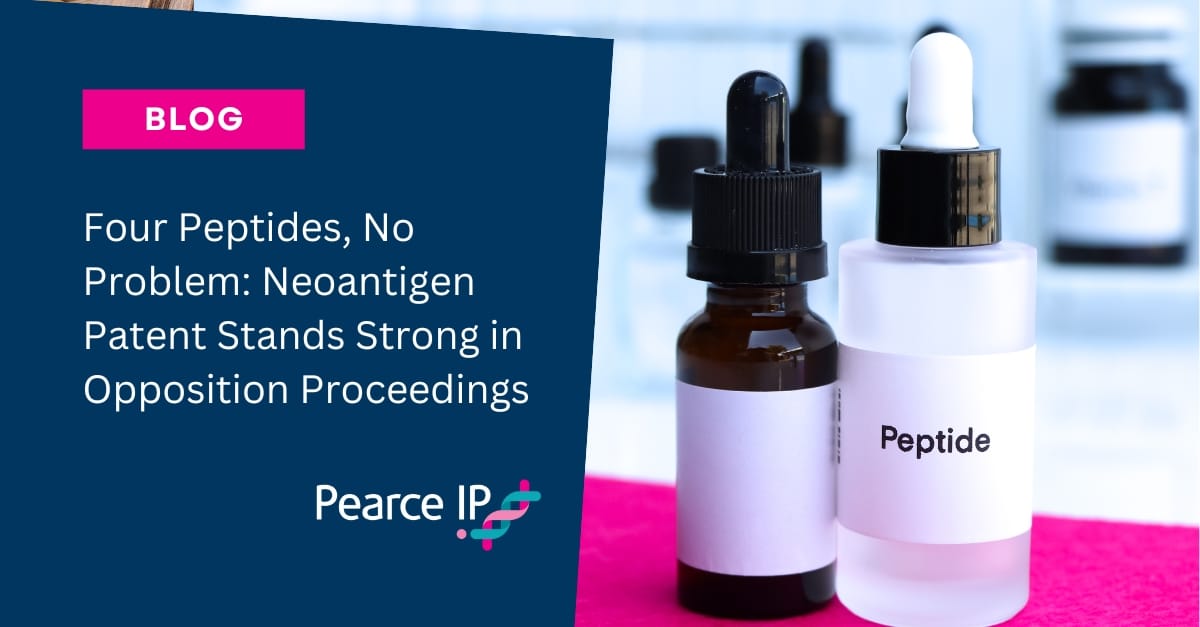| Date of decision: | 07 August 2024 |
| Body: | Australian Patent Office |
| Adjudicator: | Delegate K. Wagg |
Background
Delegate Wagg of the Australian Patent Office has ruled in favour of Dana-Farber Cancer Institute, Inc. and The General Hospital Corporation (the Applicants) in “straw person” opposition proceedings brought by QIP Nominees Pty Ltd (QIP), a company within the QANTM intellectual property group.
QIP failed on all grounds it argued, including sufficiency, support, utility, novelty, inventive step and manner of manufacture. Delegate Wagg’s decision highlights the central importance of expert evidence when mounting an invalidity challenge. QIP’s failure to support key invalidity grounds, such as sufficiency, support and utility, with adequate expert evidence led to the Delegate rejecting these grounds of invalidity.
The proceedings related to divisional application AU2018206769 (the Opposed Application) entitled ‘Compositions and methods of identifying tumor specific neoantigens’.
The claim the subject of the Opposed Application is for a personalised cancer treatment approach that identifies and utilises tumor-specific neoepitopes for cancer vaccines. The method involves three main steps:
1. Identification of DNA mutations by comparing whole genome, whole exome, or RNA sequencing of a patient’s tumor cells to their normal cells.
2. Application of validated peptide-MHC binding prediction algorithms to generate candidate T cell epitopes that may bind to the patient’s HLA alleles, based on non-silent mutations present in the tumor.
3. Optional demonstration of antigen-specific T cells against the peptides or demonstration that a candidate peptide binds to HLA proteins on the tumor surface.
This approach results in a patient-specific and tumor-specific composition comprising at least four peptides, each representing a different tumor neoepitope. These peptides are predicted to bind to the patient’s HLA alleles with high affinity (IC50 < 150 nM) and represent expression products of subject-specific and tumor-specific mutations absent in the patient’s normal cells.
Key Issues
Construction and Clarity
The Delegate first considered how the claims would be construed and whether he agreed with QIP’s allegation of lack of clarity.
One of the key issues on construction was whether, in the context of the claims of the Opposed Application, a distinction should be drawn between “a method of treatment” claim (the formulation used in the Opposed Application) and a “method for treatment” claim. The Delegate did not agree that there was “much of a distinction”, but noted that in every case the claims are to be construed in the context of the specification, the terms used and what it means to the skilled person. The Delegate agreed with the Applicants’ construction of the Opposed Application’s method of treatment claims, stating that the method of treatment indicates that the claim must treat the particular condition.
The Delegate then went on to consider a range of terms which QIP had alleged were unclear. The Delegate noted that a claim will be clear if a person skilled in the art could ascertain “whether or not what he proposes to do falls within the ambit of the claim”. The lack of a precise definition in claims may not be fatal so long as the claims provide a workable standard suitable to the intended use. However, if the monopoly defined by the claims cannot be determined, then the claims must fail for want of clarity.
Although QIP did not file submissions on clarity, QIP’s Statement of Grounds and Particulars alleged that:
1. The words “neoantigen”, “neoepitope” and “mutant peptide” used in the claims were unclear as they were used interchangeably, and that the phrase “at least 4” was vague and open-ended. The Delegate disagreed, finding that a skilled person would be familiar with these terms and their meanings in context and that they denoted a minimum of 4 peptides, with no maximum specified. No evidence was submitted that these terms would be unclear to a skilled person.
2. The phrases “bind to”, “is predicted to bind”, “the class I HLA allele”, and “IC50 of less than 150 nM” were unclear. The Delegate disagreed, finding that these terms provided workable standards and limitations, and that there was no evidence that specific affinities were required in this technology or that the terms were unclear.
Sufficiency
QIP argued that the specification did not disclose the invention in a manner which is clear enough and complete enough for the invention to be performed by a person skilled in the art. QIP contended that:
1. Not all peptides with predicted binding would work, the IC50 threshold of less than 150nM was arbitrary, and that it was implausible that everything within the scope of the claims would work. QIP relied on expert evidence that if large-scale testing was done, it is likely that more peptides with a predicted IC50 of less than 150 would show an experimentally determined IC50 of greater than 500. In reply, the Applicants relied on expert evidence which showed that all but one of the peptides with a predicted IC50 below 150nM had an experimentally determined IC50 of less than 500nM. In dismissing QIP’s arguments, the Delegate relied on the Applicants’ expert evidence, noting that large-scale testing would merely provide a low probability that one could end up with a composition where all four peptides in the composition failed. The Delegate also note that QIP had not provided any calculations of this probability or evidence as to additional peptides wherein the predicted and experimental binding affinities are inconsistent.
2. The claims, being directed to “cancer”, could not satisfy the sufficiency requirements as it would be unlikely that all cancers could be treated this way. The Delegate disagreed, finding that the method’s reliance on cancer-specific neoepitopes made it applicable to various cancer types. QIP had not provided evidence of cancers without neoepitopes or mutated peptides.
3. Carrying out the invention would be an undue burden. The Delegate disagreed, finding that the specification provided the methodology. While the application of the methodology to the specific patient required work (using genomics, algorithms and assays), the amount of work required to perform the invention was not of a type that would give rise to a lack of clear enough or complete enough disclosure.
Consequently, QIP failed to establish this ground.
Support
On Support, QIP relied on their sufficiency submissions that the claims were directed to a method of treating any cancer, yet the specification did not show the treatment of any cancer. The Delegate acknowledged that the specification did not include treatment that one would expect in a clinical study and instead included cell-based assays. Nevertheless, the Delegate identified the technical contribution of the invention as a method involving: (i) identifying epitopes in an individual’s own cancer cells; (ii) screening them for epitopes with a predicted binding of less than 150nM; and (iii) using at least four of them for a vaccine. The Delegate reasoned that it would logically follow that this methodology would work in all cancers that produce epitopes. As QIP did not file evidence of cancers that do not produce epitopes, the Delegate concluded that the claims did not exceed the technical contribution to the art.
Utility
QIP argued that the claims failed for inutility on a number of grounds, including because they did not inevitably meet the promise of treating cancer, lacked specificity in peptide amount, and failed to provide data supporting treatment across all cancer types. QIP also raised concerns about the effectiveness of peptides with predicted binding, the open-ended nature of the “at least four” peptides claim, and the lack of data on combinations with additional therapeutics.
QIP ultimately failed to prove inutility due to a lack of evidence, with the Delegate noting that “utility essentially requires evidence of something within the scope of the claim failing to meet the promise”.
Novelty
QIP relied on three scientific papers for novelty. The Delegate rejected QIP’s arguments, finding that none of the cited scientific publications provided clear and unmistakable directions to make the invention claimed in the Opposed Application. In the case of two of the scientific publications, the Delegate considered that they looked to the future, for one publication the future of what an “ideal” vaccine would be (rather than providing specific instructions on how to achieve it), and for the other publication a future approach which did not outline specific features of the claims (such as using at least 4 peptides and screening to a threshold of IC50 of <150nM). In the case of the third scientific publication, the Delegate considered that it did not disclose the use of whole genome sequencing (instead focusing on easily amplified areas of the genome), used a different IC50 threshold (500nM) than the claimed invention, and did not require at least 4 peptides to be used in any future immunological composition and method.
Inventive Step
The Opponent argued lack of inventive step based on common general knowledge (CGK) alone and in combination with prior art documents.
The Delegate first considered and rejected the lack of inventive step case based on CGK alone. In reaching this conclusion, the Delegate addressed the parties’ submissions on CGK, finding that:
1. Neoantigens formed part of the CGK, given that the parties’ experts agreed that neoantigens were known in the field before the priority date and the Opposed Application discussed neoantigens and cited several documents discussing neoantigens.
2. Use of neoantigens in cancer vaccines appeared to be an area of interest to some research groups, but how widely known they were or their use in cancer vaccines had not been established as CGK.
3. Whole genome sequencing and cancer gene sequencing were known at the priority date. The Delegate relied on the experts’ evidence to form this conclusion, noting that he did not consider that the prior art documents that used sequencing constituted sufficient evidence on their own to establish CGK in the field.
4. Algorithmic prediction of epitopes for HLA proteins was known before the priority date, however, the evidence did not establish how widely known or used these algorithms were in the field.
5. Rammensee et al., (2008) Genomics and Personalized Medicine “Cancer Vaccines: Some Basic Considerations” did not form part of the CGK. In particular, there was no evidence to show that its contents were widely known or accepted.
The Delegate then considered whether the claimed invention lacked an inventive step when compared to the CGK in combination with three prior art documents which had previously been considered for the ground of novelty. The Delegate rejected the lack of inventive step case based on the CGK and each of the prior art documents taken separately, finding that:
1. In the case of two of the prior art publications, while they suggested an ideal vaccine involving whole genome sequencing using algorithms to find potential epitopes or an “ultimate strategy” for cancer vaccines involving whole genome sequencing:
- there were key differences between the prior art publications and the invention claimed in the Opposed Application such as the IC50 threshold of 150nM and the use at least four peptides; or
- they did not provide guidance on the IC50 threshold or use of at least four peptides.
2. In the case of the third prior art publication, it did not teach the use of whole genomic sequencing, used a different IC50 threshold (500nM) than the claimed invention and did not suggest that at least four peptides are to be used.
Manner of Manufacture
QIP submitted that the requisite threshold of invention was not met as the methods of identifying subject and tumor-specific peptides were known in the art and would have been considered by a skilled person for use in cancer vaccines. The Delegate rejected this argument, noting that there was nothing on the face of the Opposed Application to suggest a lack of inventiveness, and the mere assertion that a skilled person would have thought about using neoantigens for a cancer vaccine was insufficient.
Outcome
Ultimately, QIP failed on all grounds that it argued. The Delegate directed that the Opposed Application proceed to grant and awarded costs against QIP.
Implications
The decision of Delegate Wagg offers a number of important lessons. In particular, Delegate Wagg’s decision emphasises:
1. the central importance of expert evidence when mounting an invalidity challenge. QIP’s failure to support key invalidity grounds, such as sufficiency, support and utility, with adequate expert evidence led to the Delegate rejecting these grounds of invalidity;
2. the high bar that must be met to invalidate a patent on the basis of novelty; and
3. the challenges in establishing CGK in evolving fields. Although the prior art discussed and considered neoantigen use in cancer vaccines and whole genome sequencing, this was merely a ‘promising research area’ and not widely accepted at the time.
About Pearce IP
Pearce IP is a specialist firm offering intellectual property specialist lawyers and attorneys with a focus on the life sciences industries. Pearce IP and its leaders are ranked in every notable legal directory for legal, patent and trade mark excellence, including: Chambers & Partners, Legal 500, IAM Patent 1000, IAM Strategy 300, MIP IP Stars, Doyles Guide, WTR 1000, Best Lawyers, WIPR Leaders, 5 Star IP Lawyers, among others.
In 2025, Pearce IP was recognised by Australasian Lawyer and New Zealand Lawyer’s 5 Star Employer of Choice, and is the “Standout Winner” for inclusion and culture for firms with less than 100 employees. Pearce IP was awarded “IP Team of the Year” by Lawyers Weekly at the 2021 Australian Law Awards. Pearce IP is recognised by Managing IP as the only leading ANZ IP firm with a female founder, and is certified by WEConnect International as women owned.

Naomi Pearce
CEO, Executive Lawyer (AU, NZ), Patent Attorney (AU, NZ) & Trade Mark Attorney (AU)
Naomi is the founder of Pearce IP, and is one of Australia’s leading IP practitioners. Naomi is a market leading, strategic, commercially astute, patent lawyer, patent attorney and trade mark attorney, with over 25 years’ experience, and a background in molecular biology/biochemistry. Ranked in virtually every notable legal directory, highly regarded by peers and clients, with a background in molecular biology, Naomi is renown for her successful and elegant IP/legal strategies.
Among other awards, Naomi is ranked in Chambers, IAM Patent 1000, IAM Strategy 300, is a MIP “Patent Star”, and is recognised as a WIPR Leader for patents and trade marks. Naomi is the 2023 Lawyers Weekly “IP Partner of the Year”, the 2022 Lexology client choice award recipient for Life Sciences, the 2022 Asia Pacific Women in Business Law “Patent Lawyer of the Year” and the 2021 Lawyers Weekly Women in Law SME “Partner of the Year”. Naomi is the founder of Pearce IP, which commenced in 2017 and won 2021 “IP Team of the Year” at the Australian Law Awards.

Helen Macpherson
Executive, Lawyer (Head of Litigation –Australia)
Helen is a highly regarded intellectual property specialist and industry leader with more than 25 years’ experience advising on patents, plant breeder’s rights, trade marks, copyright and confidential information. She is known for her expertise in complex, high-value patent matters and leverages her technical background in biochemistry and molecular biology to work across a wide range of technologies, including inorganic, organic, physical and process chemistry, biochemistry, biotechnology (including genetics, molecular biology and virology), and physics. Helen is an active member of the Intellectual Property Committee of the Law Council of Australia and the Intellectual Property Society of Australia and New Zealand.

Nathan Kan
Lawyer
Nathan is a lawyer specialising in life sciences, providing legal advice and litigation support across intellectual property and commercial disputes. He is passionate about the intersection of law and science, and during his time with the Science and Technology Law Association at the University of Melbourne, he helped lead events, workshops and publications across STEM fields including life sciences, AI and digital transformation.

